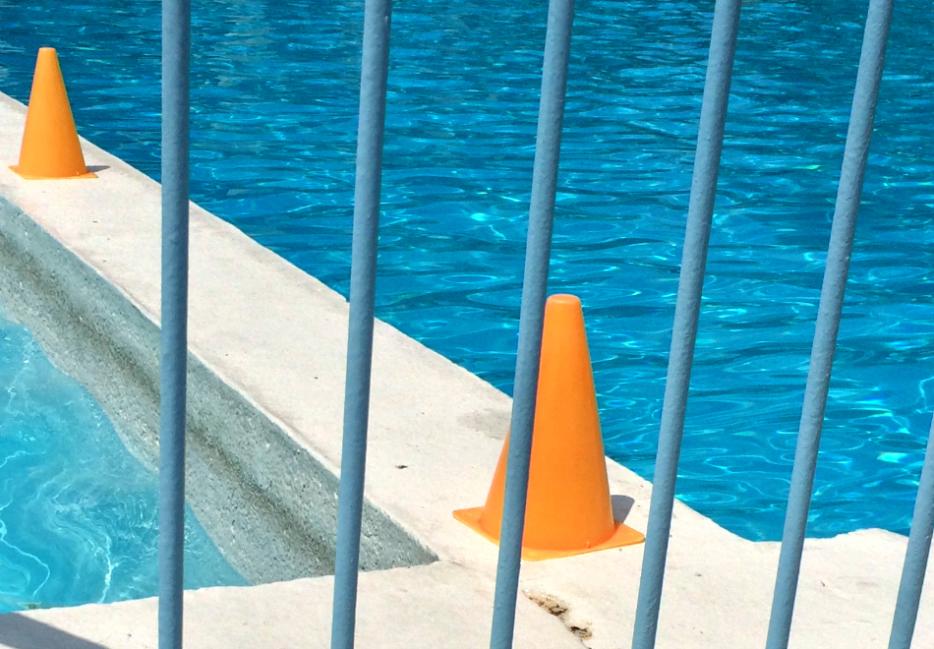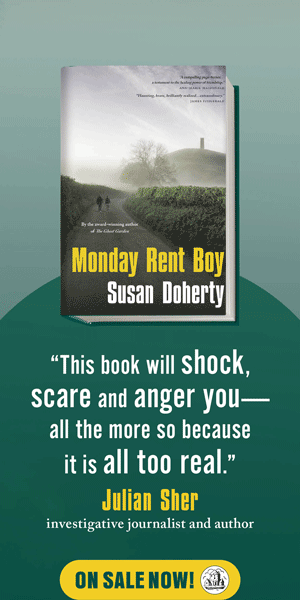"To be embraced and sustained by the light green water was less a pleasure, it seemed, than the resumption of a natural condition."
- John Cheever, "The Swimmer"
"As you know, we've been swimming, and we've developed a taste for it."
- Lisa Simpson, "Bart of Darkness"
Arrogantly, I have always believed that I am more myself in water than on land. It's just the way that water, like any true celebrity, makes one feel known and held, so long as there is air in our lungs.
When I quit my full-time job in July, I decided to resituate myself by swimming in as many outdoor public pools as I could physically take. The city of Toronto hosts a constellation of fifty-eight outdoor pools—fifty-seven currently swimmable—so I didn't lack for water, and being newly unemployed, for time. This wasn't about discovering the biggest or best in the city. Rather, I was inclined to find a path in them, so that I could feel as if I were, dear lord, going somewhere. As in John Cheever's short story "The Swimmer," I assigned myself the task of swimming home, moving through the neighborhoods and communities that, side by side, would bring me back to myself.
"The Swimmer": a jovial middle-aged Westchester resident named Ned "Neddy" Merrill, gin-drunk in his friend's backyard, announces his intention to swim home by way of the fifteen private (and one public) pools that punctuate the properties between himself and his Bullet Park mansion. This setting is powerfully Cheeveresque, to the extent that Mad Men—which shook down many of Cheever's stories for tone and content—located the Drapers' Ossining residence on Bullet Park Road, a fictional street named for Cheever's 1969 novel, Bullet Park. In "The Swimmer," Ned's impetus seems mostly romantic; a way of leaving the party in style, reassembling the built waterscape into something natural. "He seemed to see, with a cartographer's eye, that string of swimming pools, that quasi-subterranean stream that curved across the county." There's no good reason for Ned to do this, other than the fact that he wants to, and believes he can.
As a swimmer, I have no particular gifts. I have a serviceable stroke and an absurd kick. I love to dive and somersault and generally roughhouse. My identity as a swimmer is as much defined by the pools, lakes, and swimmin' holes I've swum as the ones I've encountered in art, film, and literature. Mostly, I just enjoy being in the water; the leisure, the coolness, and the distance from anything resembling work. The almost ekphrastic pleasure of reading about something set in or near a pool provides its own bone-dry satisfaction.
"The Swimmer" was published in the July 18, 1964 issue of The New Yorker, 55 years before I decided that I too would swim home. On my laptop, I examine a map of the city's pools, tracing a line between the ones that form a jagged nautilus spiral towards my apartment. I am compelled to do it the way billionaires seek Everest and, presumably, further billions. I will swim across the city, because I want to, and believe I can.
Day I—Three pools (Riverdale Park East, Kiwanis, Monarch Park), 32 km cycled
I cycle to Riverdale, and then East York, passing a football field dotted with hundreds of motionless seagulls. I admire the mid-rise apartment complexes and their vainglorious names: Terraces, Towers, and Arms. They seem beautiful and banal and untouched in the way that I don't associate with Toronto, a city of cranes and Crane Girls.
Nested in a leafy little enclave is Monarch Park, my third pool of the day after large and liminal Riverdale Park East and sunny, sweet Kiwanis. I fold my clothes into a mustard yellow locker that bears the warning AMANDA'S don't touch OR ELSE, with the rebuttal, OR ELSE WHAT BITCH, scratched in below.
The Monarch Park pool boasts an intriguing macaroni shape with a robin's egg blue slide nestled into its bend, a generous concrete deck, and lots of comfortable seating. I position myself in a purple plastic Muskoka chair behind the deep end lifeguard. A set of adult twins scream unintelligibly, pelting a tiny Nerf football at each other. There are a good deal of adults and small children—fairly consistent at every pool I visit. But Monarch Park has different social patterns, with the kids all playing together, and parents pulling their chairs together in a circle to gossip and flirt. The soft, divided idyll reminds me of Tom Perrotta's novel Little Children, about an extramarital affair between two lost adults that is, in part, cultivated at the town pool. "As badly as Sarah sometimes wanted to just grab Todd by the face and kiss him, to crawl onto his towel and blast away the pretense that they were just a couple of pals killing time together, she wanted just as badly to hold on to the innocent public life they'd made for themselves out in the sunshine with the other parents and children."

The adults watch as their respective children play at the far end of the pool, one of them with a shark fin strapped to her back. The "innocent public life" that Perrotta articulates is a rare form of peace that thrives at the public pool. "If they had an affair, all this would have to head underground, into a sadder and darker and more complicated place. So she accepted the trade: the melancholy handshake at four o'clock in exchange for this little patch of grass, some sunscreen and conversation, one more happy day at the pool," writes Perrotta. In the water, I flip around aimlessly like a happy seal, warming my face in the late afternoon light as the laughter of adults, and more distantly, children, floats over me.
Pools, like people, can be both subject and object. We swim in them, soak them into our hair and let them dissolve our swimsuits with the same chemicals that protect us from spontaneous algae blooms. But we also love to just look at them. Three years after Cheever wrote "The Swimmer," David Hockney painted A Bigger Splash, which pins the moment after a dive against a still pastel background, the splash itself the only kinetic presence. The painting is nebulously referenced in Luca Guadagnino's 2015 feature film of the same name, a sensual thriller that features—as does his earlier feature, 2009's I Am Love—a pool-related death. In both the painting and the film, the person who authored the splash never transcends it. What remains is water.
Pools are naturally erotic, like the language we use to describe them—aquamarine, sapphire, azure, and cerulean—all the horny words for a blue you can't quite hold onto. They are also natural sites of tension (drowning, social exclusion, sunburn). They are places where we reveal our bodies to each other in public anonymously, above and below water. Pools were the first public spaces where it was socially acceptable to be somewhat undressed, and cinema, like the Esther Williams aquamusicals of the 1940s, normalized the female body in a tight maillot, bullet tits and all.
On film, pools grant directors permission to linger on bodies outside of the bedroom, private with a public conceit. Bunny painting her toenails in The Big Lebowski, Elle Woods's aerial view Harvard Law School video application, all the pool party scenes in Boogie Nights, Sebastian flashing his peach emoji butt at Annette in Cruel Intentions, Clueless's opening montage where Cher Horowitz asks, "Is this like a Noxzema commercial or what?" But none of this happens at the public pool. In Perrotta's Little Children, sex is carefully avoided to maintain the purity of the space.
Sex is one of the fantasies of the private pool, to be bought and enjoyed in one's own backyard. Public pools are where the possibility of sex originates, which is its own thrill.
Day II—Two pools (Donald D. Summerville Olympic Pools, Greenwood Park), 25.1 km cycled
Never have I seen such density of children in my life. They're everywhere, campers with the city's various programs wearing backpacks as big as they are. They come streaming in shortly after my friend Tess and I lay out our towels (she forgot one, so in a compromise, spread out her shorts and T-shirt, in the shape of a flattened body). The Donald D. Summerville Olympic Pools in the Beaches is a fascinating structure, a big concrete stadium cantilevered aboveground to avoid the pre-existing utilities that digging would've interfered with. The effect is a wide view of Woodbine Beach, volleyball players, bathers, and the lake, with a thick haze hovering over the water. Through the puddle-filled and somewhat decrepit change room, then upstairs, we're met with an impressive sight: a 50-metre Olympic, perpendicular to which is a smaller, shallow pool where campers, children, and their parents play together, even a few babies. At the far end is a diving pool with two springboards, plus a five- and ten-metre diving tower. Tess and I dare each other to jump from the five-metre platform, which was much much much scarier than I thought it would be at deck level. Around us, zealous teenagers bellow commands and scoldings through plastic cones. We are all, it seems, making huge mistakes.
It is worth noting that the aforementioned characters—Little Children's Sarah, Elle Woods, Bunny Lebowski, Annette Hargrove, and Cher Horowitz—are all white, and as I moved from Riverdale Park East (which, incidentally, has a huge slide), to Kiwanis, to Monarch Park, to the Beaches, I was aware of the fact that these movies aren't indicative of the diversity of contemporary public pools. At Kiwanis, I was delighted to see a row of bikini babes lying in the sun, punctuated by two women in burkinis doing the same.
In his book Contested Waters: A Social History of Swimming Pools in America, Jeff Wiltse writes that "a social transformation occurred at municipal swimming pools after the mid-century. Black Americans challenged segregation by repeatedly seeking admission to whites-only pools and by filing lawsuits against their cities." On the first leg of my pool tour, I saw the city at its most diverse—age, race, ethnicity, religion, gender, and body type. As Wiltse points out, the public pool was (and is) a place where class was visually erased, swimming attire being more-or-less universalizing. Swimming became socially acceptable within the middle and upper classes as more resorts and athletic clubs dug pools that were suitably genteel (the invitation-only New York Athletic Club built an extravagant affair of marble and tile, with a row of chandeliers). This was followed by the private pool boom of the 1950s, motivated—much like the white flight to suburbs like Cheever's Westchester—by the integration of public spaces. Public pools, like so many things, have been shaped by white supremacy. Is it any wonder that in all these movies, private pools are almost uniformly white spaces, whereas public pools, like the one in Cheever's story, were viewed as vulgar and chaotic.

In a recent New York Times piece, "Women Crash the Pool Party," Amanda Hess writes about how swimming pools became a symbol of opulence and exclusivity partly through their role in segregation. "The glittering image of white luxury rested on barring black swimmers; if a person of color set foot in a whites-only 'public' pool during Jim Crow, it would be drained." Interviewed in The Guardian in 2015, Wiltse remarked that from racist preconceptions about "black people carrying communicable diseases," these kinds of extreme and alienating policies were primarily enforced because of "white anxieties about black men interacting with white women in an intimate public space." These measures were particularly damning for children, and the legacy of this municipally sanctioned marginalization is still felt today. "Black people in the United States drown at five times the rate of white people," writes University of Toronto academic Jacqueline L. Scott in her article "Swimming while Black," and one of the most pervasive stereotypes to this day is that black people simply don't like to swim. In fact, they have historically been robbed of safe and inclusive opportunities to do it.
North American public pools had to do with skin right from the start. They were first created as a cheap and accessible method by which the poor—who had no running water in their homes—could bathe, and therefore not bring their diseases to bear on citizens who had private baths in their homes. In 1888, public baths were declared a "profitable sanitary investment," founded on a dubious understanding of how diseases were spread, and a desire to keep the working-class immigrants and people of color in their own, usually badly neglected, neighborhoods. But they didn't stay that way.
As Wilste writes, pools were originally segregated along class and gender lines. Sex and poverty were the most pressing threats, so people of all ethnicities swam in the same pools, if not precisely together. The late 18th century saw a boom in swimming culture, with boys and men swimming naked in rivers and lakes, in full view of polite society. Cities like Chicago, Boston, Philadelphia, and New York had swiftly ballooning populations, and municipal infrastructure wasn't prepared for the cultural and material needs of the working classes. They experimented with indoor public pools for bathing, as well as river baths, ingenious covered shelters that perched in the water, protecting swimmers from being dragged away in strong river currents, and passersby from the impropriety of public nudity.
In 2019, Toronto's public pools are uniquely equipped for the needs of different swimmers. Fourteen public pools schedule Female Swim programs to reflect different religious and cultural requirements. Likewise, they also offer Open and Inclusive (LGBTQ2) Swim, "incorporating all gender expressions and body types," and Adapted Swim programs for those with special needs and/or disabilities. The inclusive work of Toronto's public pools practice seclusion rather than segregation. By creating a safely demarcated margin within a public space, those who were previously left out are now able to participate on their own terms, a right that someone like me has always taken for granted.
Water doesn't discriminate: it wants to kill us all equally. Not so long ago, white people decided who could get in and who couldn't, and in many American cities, the result of that remains. We all deserve to learn to swim; to be told by a patient adult that floating is as natural as breathing. Who would I be without these things? And where? Surely not jumping from a five-metre diving tower. I watch a group of children, seven or eight years old, take their turns on the platform. Each one is palpably terrified, clinging to the rail. Down below, they cheer, brightly calling, "You can do it, Sophia!" One child mutters what might be a prayer, or self-hype, at the edge of the platform before flinging herself off. Pools teach us to be brave in short bursts, a lesson that carries on land.
Day III—Two pools (Sunnyside Gus Ryder Outdoor Pool, High Park), 14 km cycled
Sunnyside Gus Ryder is one of the oldest pools in the city, featuring a stucco pavilion with an incontestable Mamma Mia! vibe. Like the Beaches pool, it is flanked by the lake, murky and foul-smelling today. From 1922 to 1955, Sunnyside was a resort, complete with amusement park, pleasure boats, and beauty contests, before being demolished to make space for the Gardiner Expressway. The pool and pavilion remain, and the Gardiner's sharp division makes Sunnyside feel both remote and hectic.
In "The Swimmer," Ned's experience of the public pool is a very recognizable form of hell. "The sounds here were louder, harsher, and more shrill, and as soon as he entered the crowded enclosure he was confronted with regimentation. 'ALL SWIMMERS MUST TAKE A SHOWER BEFORE USING THE POOL. ALL SWIMMERS MUST USE THE FOOTBATH. ALL SWIMMERS MUST WEAR THEIR IDENTIFICATION DISCS.'"
Sunnyside has more rules than any pool I've attended thus far. A refreshingly apologetic teenager forbids me from bringing my bag poolside, and so I carry my stuff out to the deck, all of it getting soaked as I pass through the mandatory showers. Sunnyside pool lacks the typical sharp corners and is instead rounded off like gift soap. It is ringed by a vented plastic gutter which a) swallows the choppy waves made by the swimmers and b) permits the deeply tanned, Speedo-wearing seniors to perch happily on it, their legs dangling into the water. There are no chairs on the narrow deck, just a concrete ridge that lines the pool and backs against a chain link fence. I put down my towel and am immediately swarmed by flies.
In her book Swimming Studies, the writer and artist Leanne Shapton tells the quiet story of her early life as a near-Olympian swimmer, and the way that swimming follows her into adulthood, from training with swim clubs, to cold ponds, to hotel pools. "As I swim, my mind wanders," she writes. "Mundane, unrelated memories flash up vividly and randomly, a slide show of shuffling thoughts." She writes later of scaling the chain link fence to go night swimming in the Sunnyside Gus Ryder Pool "with two friends named Jason." My mind, too, has been drifting down a lazy river of faintly related thoughts and memories. Inspired by Shapton, all the bathing suits I've owned; the golden age of Speedo (1996); the wow now very sulfuric smell wafting over from the lake; transmission of E. coli.

Mostly, I think of the pools. I have spent more time in them this week than I have in my whole adult life. I've peed in public bathrooms wet with puddles that never dry. I've seen purple, yellow, green, and blue slides, each of them controlled by a taciturn youth. I've seen huge, and I mean Ben Affleck huge, back tattoos. I've witnessed a lifeguarding mascot in a large brown dog costume wave as his pants fell down without his noticing. I've doubled over with laughter as four or five adults frantically ran to pull the dog's pants up, struggling to tuck his tail through a hole in the back of his sweats. I've swum in rectangular pools and oblong pools and pools with diving boards and pools with no deep ends. I've swum laps in the slow lane and the medium lane, I've dropped from a five-metre diving platform, after which two teen boys in soaking wet T-shirts asked me if that hurt, because I was "pretty angled." I've eaten melted peanut butter sandwiches for every meal, most of them flavoured with sunscreen. I've taken off my bathing suit at the end of the day and seen a photogram of it left on my body. Everything I own reeks of pool, and I feel as if I've entered a happy, nudity-filled, sunburned civilization that exists while everyone else is at work.
At Sunnyside, I alternate between reading and lapping the warm droplets of water at the bottom of my Kleen Kanteen. Ned "took a shower, washed his feet in a cloudy and bitter solution, and made his way to the edge of the water. It stank of chlorine and looked to him like a sink. A pair of lifeguards in a pair of towers blew police whistles at what seemed to be regular intervals and abused the swimmers through a public address system."
At 4 p.m., a stern teenager announces that the pool will be closing, so please, get out. It is, quite frankly, a relief. As I flee, I realize I didn't actually get in the pool. I've been frankly surprised by the sheer quantity of nice kids in these pools, but Cheever did get one thing right: the lifeguards and their whistles, towers, and megaphones. It's humbling to be yelled at so regularly by teens in aviators, but this is my life now.
Day IV—Three pools (Stanley Park South, Alexandra Park, Giovanni Caboto Outdoor Pool), 16.4 km cycled
Alexandra Park is the only outdoor pool not in service this summer due to extensive repairs (although the tiny Stanley Park South pool was also closed today on account of a "fouling"). Currently hidden by covered chain link fences, Alexandra Park was oddly exposed so far as pools go, adjacent to the busy Toronto Western Hospital, a McDonald's, and Tim Hortons. It's a chaotic intersection, with streetcar tracks going in both directions, treacherous for cyclists. As a location, it's anomalous compared to the pools I've been to, all of them plotted in protected swatches of green or sand as they mostly seem to be. I peer in through a gap in one of the barriers. The grey concrete pitches towards a deep end where a bunch of workers in orange vests and safety hats discuss, one assumes, the pool.
Seeing a pool drained of water is like catching it naked, the bottom no longer banded with squiggles of light. "The breach in his chain of water disappointed him absurdly, and he felt like some explorer who seeks a torrential headwater and finds a dead stream," observes Ned upon finding an empty pool at the Welchers'. The film of version of "The Swimmer" depicts this scene much differently than the story, with Ned (played by a perfectly maniacal Burt Lancaster) tending to the needs of a lonely little boy who is afraid of the water. The two of them climb down into the empty tank of the pool, and Ned leads him in a pantomime of swimming across the bottom. They argue about whether it counts as swimming, although it's obvious that both of them want to believe it is. As Ned makes his way to the next pool, he hears the boy bouncing on the diving board and runs back, grabbing him in a hug, believing that the boy was about to dive into the empty pool.

In Samantha Hunt's novel Mr. Splitfoot, Ruth and Nat, two foster kids recently sprung from their cultish home, develop a séance scam where they play at being mediums, connecting the bereaved to their loved ones. Ruth, who believes that only she is the fraud, realizes that Nat is also faking it when he quotes a scene from the The Swimmer, which they'd recently seen on television. "Nat chuckles as if in response to an unheard dirty joke. His head swivels, lifting his left ear to the sky, then his right. His eyes are white. 'What's the matter? I thought you were going to dive. You thought I was going to dive? There's no water in the pool.'" Nat quotes Lancaster as Ned, parlaying a fragment of a movie based on a story into something he thinks these people will want to hear.
Empty pools become dugout stages for performance, and dangerous as they are, they also present an opportunity to amend history. In "Women Crash the Pool Party," Hess writes that Beyoncé challenged the history of racism and segregation of pools in her "Formation" video. "Spliced with shots of a flooding New Orleans, a crew of black synchronized 'swimmers' creates its own waves at the bottom of an empty pool."
Day V—One pool, one splash pad (Alex Duff Memorial Pool, Christie Pits), 2 km walked
Each time I read "The Swimmer," I'm delighted by the childishness of the premise, the hero's journey skewed through the driving intent of the fanatic, the delusional, the drunk. I love the mean Waspy voices whose dialogue penetrates Ned's cocksure inner narrative. But what I savour, cruel bitch that I am, is the chastening conclusion—Ned exhausted and thrust face-first into some version of reality. Most of the story I spend hating him, but at the end, I feel compassion for him, his pain, his need to keep swimming if only to prove that he's not drowning. "The Swimmer" is the bender, the hangover, and the agonizing humility of sobriety, something that Cheever—a writer whose own alcoholism was a defining part of his literary aesthetic—would've known intimately.
My mother was an alcoholic for as long as I knew her—a negligible 16 years. My understanding of drinking came when she was hospitalized during a particularly potent case of alcohol poisoning. I grew up hating the smell of alcohol, the way my high school friends swayed and slurred at house parties after mixing Schnapps and wine and whisky and before puking in the laundry room. But I was also sensitive to being perceived as a narc and worked hard to appear cool with it. Eventually, I did become cool with it. In my thirties, a few drinks quickly crowded out the day's stress. "Mommy needs a wine," I'd declare upon entering my vacant apartment each evening, only now realizing the implications.
I began feeling inexplicably very sick and was instructed to cut out alcohol and Tylenol. "But my treats!" I replied, to Dr. Yu's scant laughter. Nearly two years after my last drink, I still remember the feeling of warm deflation, yielding to the undertow of my own body. As Ned swims from one pool to the next, he fuels himself with gin, wasted as much by the booze as by his own physical efforts. I think of the bottles of Bombay Sapphire I occasionally bought, blue as any pool.
It's been raining for the past few days, but today it is sunny and mild. I walk to the Alex Duff Memorial Pool—ten minutes from my house and the most crowded pool yet. I put my towel down in the shade and make my way over to the zero-depth ramp, slowly pushing into the icy water. It's sunny, but windy out, and even when I dip my head and shoulders, I feel the cold of the water penetrating my bones. "He was cold and he was tired," Cheever wrote of Ned, emerging from one of his pools, still so far from home. A child gently touches my shoulder and then floats away, murmuring, "Sorry." I had intended on swimming a few laps at every pool I attended, but here, I simply can't. I am too cold and too tired and my throat and nose sting from all the chlorine. I am sick of the sun, the sharp snap of voices, the damp towels, and broken water fountains. I leave quickly, pulling my shorts and tee shirt on over my wet suit. Walking through Christie Pits, I wade into the sun-soaked splash pad, absolutely bumping with infants. The spray hits the water, dimpling the surface hypnotically. I appear to be the only adult actually in the water, but I'm too drowsy to be embarrassed. I trudge home and take an excessively soapy shower. I pull on dry clothes, pulsing with sunburn. I am home.
In the muted but terrifying final scene of "The Swimmer," a distinctly beaten-down Ned staggers up to his house, attempting to open the front door. He blames "the stupid cook or the stupid maid" before remembering that there is no cook or maid anymore. "He shouted, pounded on the door, tried to force it with his shoulder, and then, looking in at the windows, saw that the place was empty."
As all of us do, I dream frequently about my family home, sold long ago. After one of these dreams, I wake up confused and ungrateful for the apartment that uncomplainingly houses me. It is not, I believe, the right home. But every evening when I returned from the pools, it did feel that way, when I have so often and inexplicably felt like Ned Merrill, powerless to return to the seat of his vitality. That feeling is already fading, and I believe it had more to do with being at home in my body and in the city than in the actual place where I delivered myself at the end of the day.
On September 2, all of Toronto's outdoor pools will close for the season, signaling the end of summer. But there is a long winter ahead, and a quasi-subterranean stream of indoor pools that might, I suspect, continue to carry me home.






